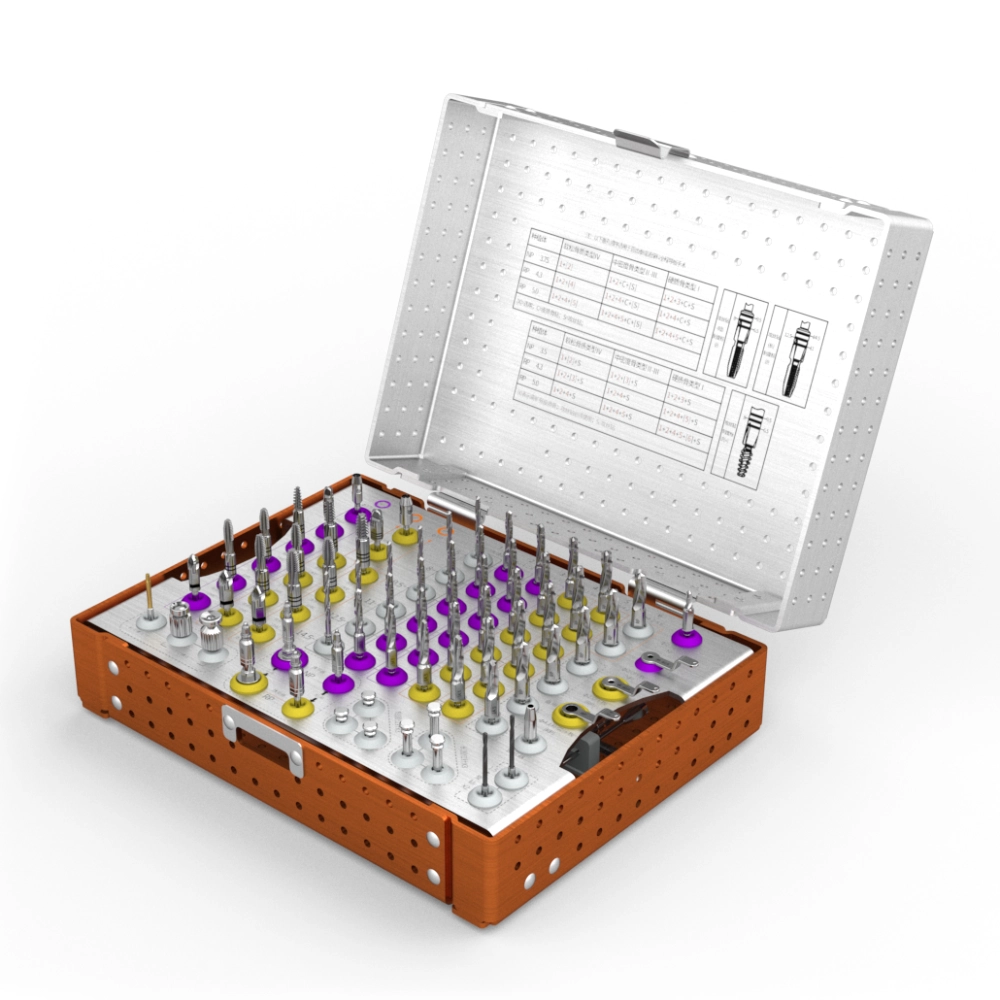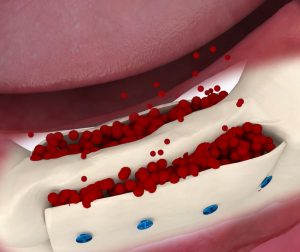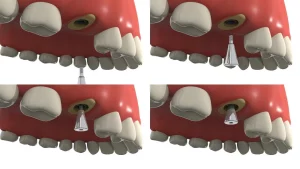Guided surgery kits play an irreplaceable role in modern surgical procedures, particularly in fields requiring high precision, such as dental implantology. With continuous advancements and innovations in technology, we can expect the emergence of more advanced and efficient surgical kits in the future, providing better support for patients’ health and quality of life.
With the development of Computer-Assisted Surgery (CAS), the application of dynamic navigation systems in dental implant procedures has become increasingly prevalent. Compared to static surgical guides, dynamic navigation systems offer higher precision and flexibility, allowing real-time changes and adjustments to treatment plans during surgery to better meet clinical requirements. Additionally, the implant process under dynamic navigation closely resembles freehand implant placement, offering greater comfort for patients.

What Are Guided Surgery Kits?
A guided surgery kit is a specially designed set of medical tools that assist in performing surgical procedures. It typically includes a series of precisely designed and optimized surgical instruments and materials. These tools and materials play a critical role before, during, and after surgery to ensure smooth procedures and patient safety. The primary goal of guided surgery kits is to provide greater surgical precision and reduce risks, especially in dental procedures requiring meticulous accuracy.
In dentistry, the significance of guided surgery kits is particularly prominent. With the development of modern dental technologies, precision implantology has become an essential treatment method. It not only requires clinicians to possess solid theoretical knowledge and excellent surgical skills but also relies on advanced medical equipment and technology. Guided surgery kits are designed to meet these demands.
What Is Precision Implantology?
Precision implantology is a key technology in modern dentistry. It involves using highly biocompatible materials, such as titanium alloys, which are implanted into the alveolar bone to replace missing tooth roots. Prosthetic teeth are then mounted on these implants, restoring the patient’s chewing functionality and aesthetic appearance. This technology, known for its exceptional functionality and aesthetics, represents a significant breakthrough in modern oral rehabilitation.
The Importance of Precision Implantology
- Improves Surgical Success Rates:
Through precise surgical planning and guidance, implants can be accurately placed, significantly improving the success rates of procedures. - Reduces Surgical Risks:
The instruments and materials included in guided surgery kits undergo strict sterilization and quality checks, ensuring a sterile environment and minimizing infection risks during surgery. - Enhances Patient Quality of Life:
Precision implantology restores chewing efficiency and aesthetics close to natural teeth, significantly improving patients’ quality of life. - Protects Alveolar Bone:
Dental implants help preserve the alveolar bone, preventing bone resorption and facial deformities caused by tooth loss.
Guided surgery kits, when combined with dynamic navigation technology, represent a revolutionary tool for enhancing the accuracy and efficiency of implantology procedures, ultimately ensuring better outcomes for both clinicians and patients.
How Guided Surgery Kits Improve Implant Precision
Guided surgery kits significantly enhance the accuracy of implant procedures through a series of precisely designed instruments and materials. Below is a detailed explanation of how surgical guide technology, digital techniques, comparative case studies, and the critical role of digital workflows contribute to improving implant precision.
1. Application of Surgical Guide Technology: Achieving Precise Positioning
Surgical guide technology is a key component of guided surgery kits, enabling precise positioning during procedures. As a surgical navigation tool, the guide ensures instruments operate along the pre-determined path and depth. In implant surgeries, guides direct implants to be placed according to the pre-surgical plan, significantly improving surgical accuracy.
Specifically, guide design is typically based on the patient’s 3D imaging data, such as Cone Beam CT (CBCT) scans. Surgeons can simulate the surgical process on a computer, determine the optimal implant location, direction, and depth, and translate this information into the guide’s design parameters. During surgery, the guide fits tightly with the patient’s bone structure, providing a stable reference plane for surgical tools and enabling precise positioning.
2. Digital Technology Reduces Errors and Boosts Success Rates
The integration of digital technology into guided surgery kits further minimizes errors and enhances success rates. With digital technology, surgeons can conduct more precise preoperative planning and monitor and adjust the surgical process in real-time.
Digital techniques include 3D imaging, Computer-Aided Design (CAD), and Computer-Aided Manufacturing (CAM). These ensure the precise manufacturing of surgical tools and guides. Additionally, digital technology can monitor surgical errors in real-time, alerting surgeons to make necessary adjustments. Together, these measures reduce intraoperative errors, improving surgical precision and outcomes.
3. Comparative Case Studies: Traditional Implantation vs. Guided Implantation Precision
Guided implantation offers significant precision advantages over traditional methods. Traditional implant surgeries primarily rely on a surgeon’s experience and tactile feedback to judge the implant’s location, direction, and depth. However, due to the complex anatomy and individual differences in the oral and craniofacial region, traditional methods often result in errors.
In contrast, guided implant surgeries, aided by surgical guides and digital technology, enable more precise determination of implant position, direction, and depth. Clinical data shows that guided surgeries achieve an accuracy of less than 0.3mm, while errors in traditional surgeries may reach several millimeters. This improvement not only reduces surgical risks but also enhances success rates and patient satisfaction.
4. The Critical Role of Digital Workflows in Guided Implantation
Digital workflows are essential to guided implant surgeries. The following outlines the key stages of a digital workflow and their functions:
Combining Digital Imaging with Planning Software
- Use CBCT and other digital imaging technologies to obtain 3D data of the patient.
- Analyze and process imaging data using planning software to determine the optimal implant location, direction, and depth.
- Translate planning results into guide design parameters for manufacturing.
Guide Design and Its Role in Surgery
- Guide designs are based on preoperative planning, ensuring a tight fit with the patient’s bone structure.
- During surgery, guides provide a stable reference plane for instruments, directing implants to follow pre-set paths and depths.
- The use of guides reduces intraoperative errors and improves precision and success rates.
Improving Efficiency and Patient Satisfaction Through Digital Workflows
- Digital workflows simplify surgical procedures, reducing operation time and complexity.
- With precise preoperative planning and intraoperative monitoring, digital workflows lower risks and improve success rates.
- They also enhance patient satisfaction due to the increased predictability and accuracy of surgical outcomes.
Features and Highlights of the DentalMaster Guided Surgery Kit
Key Features
- Precision: Utilizes digital guide technology to ensure optimal implant placement and angulation.
- Versatile Tools: Includes a range of instruments like drills and guide sleeves, adaptable to various clinical needs.
- Ease of Use: Modular design simplifies procedures, suitable for both experienced and novice practitioners.
- Compatibility: Supports a wide range of implant systems for enhanced flexibility.
Applications
- Single or multiple tooth restorations.
- Complex cases with insufficient bone volume.
- Boosts the success rate of initial implant placement and restoration.
Why Choose Guided Surgery Kits for Implant Procedures?
Opting for guided surgery kits for implant procedures significantly enhances surgical precision, efficiency, and patient satisfaction. These kits also offer economic benefits and elevate a clinic’s professional reputation. Below is a detailed analysis of these advantages:
1. Economic Benefits of Guided Surgery Kits
Reducing Surgical Complications and Postoperative Adjustments
Guided surgery kits leverage digital workflows and guide technology to minimize errors during procedures, reducing the likelihood of complications. Additionally, the precise placement of implants minimizes the need for post-surgery adjustments, saving both time and costs for patients while lowering a clinic’s follow-up treatment expenses.
Improving Clinic Profitability
The increased success rate and reduced complications associated with guided surgery attract more patients, thereby boosting procedure volume and overall revenue. Furthermore, shorter surgeries and improved efficiency enable better resource utilization, enhancing the clinic’s economic performance.
2. Enhancing Patient Trust and Clinic Professionalism
Building Patient Trust
Guided surgery kits significantly improve surgical precision and success rates, reducing patient discomfort and complications. This fosters greater confidence in the procedure and strengthens patient trust in the clinic, leading to increased loyalty and positive word-of-mouth referrals.
Elevating Professional Image
Implementing advanced digital workflows and guided surgery kits showcases the clinic’s technical expertise and professionalism. This not only attracts more patients but also bolsters the clinic’s reputation and competitiveness within the dental industry.
Conclusão
When selecting solutions for implant procedures, clinics should fully consider the core advantages of guided surgery kits: precision, efficiency, and patient satisfaction. These strengths not only improve surgical success rates and patient outcomes but also deliver substantial economic benefits and elevate the clinic’s professional image.
The integration of digital workflows and guided surgery kits has become a key trend in modern dental implantology. By enhancing surgical precision, efficiency, and patient satisfaction, these tools offer clinics significant economic advantages and professional recognition.
Choosing guided surgery kits for implant procedures is a wise decision. They not only enhance surgical precision and success rates but also contribute to economic gains and reinforce the clinic’s reputation. We encourage more clinics and dentists to adopt this advanced solution to provide superior treatment experiences for their patients.





